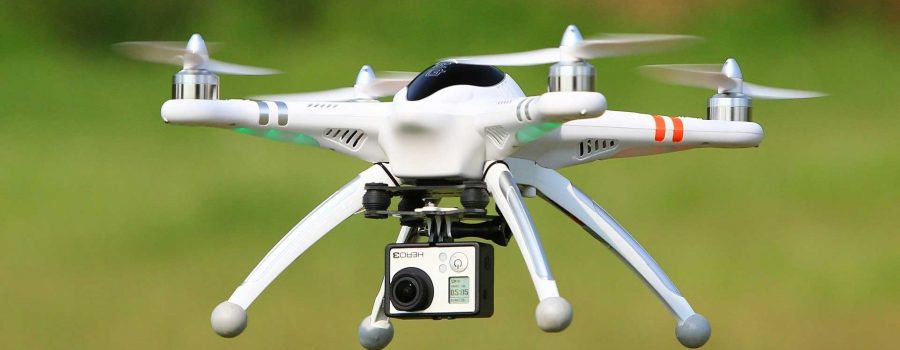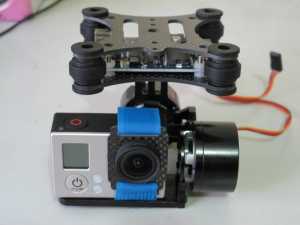
Learning to Fly a Drone
For quite some time I’ve wanted to have a drone to capture aerial footage and offer this as part of our video production services. It was only at NAB 2014 when I saw a product that seemed to be a DJI copy but cost less money that I decided it was time to buy one. It was an OEM version of the Walkera QR X350 multi-rotor that I bought as well as options including a brushless gimbal  mount for a GoPro camera and a receiver that allowed seeing the video the camera was recording; all for around $1000. I thought this would be a good learning tool before spending much more money for a drone that could hold a DSLR.
mount for a GoPro camera and a receiver that allowed seeing the video the camera was recording; all for around $1000. I thought this would be a good learning tool before spending much more money for a drone that could hold a DSLR.
For those that don’t know what a gimbal is, it is a camera mount that automatically compensates for flight movement and keeps the camera level. The receiver has a video screen that receives video transmitted from the camera while flying.
I bought a GoPro 3+ Black Edition which captures better than HD, 2.7k video at 30P and began to do some test flying. I think I was over confident and thought I could just take off and fly the  drone. Because I was the world champion 1/24 scale slot car champion in 1984, because I had flown real planes, raced motorcycles and driven all types of racing vehicles I thought flying a small drone would be easy. Boy was I wrong!
drone. Because I was the world champion 1/24 scale slot car champion in 1984, because I had flown real planes, raced motorcycles and driven all types of racing vehicles I thought flying a small drone would be easy. Boy was I wrong!
The documentation you receive is terrible and there are no online manuals which adequately describe how to set the receiver options. For example, when the battery starts getting low, it beeps. This is something you find out the hard way.
I didn’t understand the importance of setting compass settings so that when you press the joystick forward it will go in that direction. The first time I flew was a disaster, I couldn’t control it and brought it down for a hard landing. Fortunately I was in a field and there was no damage. At this point I took the camera off to avoid damage while I was learning how to fly. That was a good thing.
After learning about setting the compass the next day I tried again but this time in my rush to fly I ignored the fact that there was a 25MPH wind. This flight ended up in a pond. After fishing it out, I dried it and decided that I would buy another one for mounting the camera and use this one for practice. From this experience I learned that you don’t fly a multi-rotor drone of this size in a fierce wind.
My next flights with the drone that had “swum with fishes” but survived went pretty well. Without the camera I learned how to control it, take off, and land. I found out you could go hundreds of yards straight up in the air and about at least 300 yards away and still have control. I learned  about flipping a lever which let it hover at an altitude without having to do anything else. I learned how to flip the lever to a second position and how the drone would land automatically from where you took off.
about flipping a lever which let it hover at an altitude without having to do anything else. I learned how to flip the lever to a second position and how the drone would land automatically from where you took off.
When my new unit came in, this was disaster number three because this one being different didn’t control the same and what I came to realize, it didn’t control very well period. Who knew! I thought it would fly like my first unit and thought nothing of taking it off from my driveway. It was a small area and because of the trim difference and apparently some malfunction in this second unit I had limited control when I took off and had to bring it down fast before crashing into my house. Oops, another really hard landing onto a concrete driveway! With the other crashes I hadn’t really broken anything; this time I did. I put a scratch on the GoPro lens and broke the camera gimbal. From this I learned that this stuff is FRAGILE!
I repaired the gimbal with some epoxy and put it back on the first drone that I knew I could fly. With this I took some aerial video which I’m showing below. On this flight, I ran out of battery  and the drone landed automatically in a sand trap on the golf course. From this I learned when you hear the beep from the transmitter, land! I also learned that the video range for transmitting what the camera sees was only a couple of hundred feet; way below the mile of range I was told it had.
and the drone landed automatically in a sand trap on the golf course. From this I learned when you hear the beep from the transmitter, land! I also learned that the video range for transmitting what the camera sees was only a couple of hundred feet; way below the mile of range I was told it had.
As time has gone by I’ve learned to fly reasonably well. I have a new gimbal ordered for the second drone and once we find out why it doesn’t control well we’ll be back in business with a camera mounted on both. In the meantime I’ve really improved on flying and actually made some modifications to the drone which make it much more stable for take offs and landings plus provides protection for the camera and gimbal. I’ll mention the details in a subsequent blog .
I’ve also done quite a bit of internet research on parts and other resources. Most of the parts come from China and there aren’t always good English translations for operation. I’m convinced this technology is in it’s infancy and will mature with better products as time goes by.
Tags: aerial video, aerial videography, drone nevada, gopro, helicopter drone, hero3, Las Vegas Video Production, walkera qr x350



As we discussed quite some time ago out firm pioneered the use of HD drone video in real estate marketing which has received tremendous coverage and many accolades. I know from first person experience working with you in the past you will succeed in you attempt at learning to fly and become the Las Vegas expert providing this service to your audience. All the best…